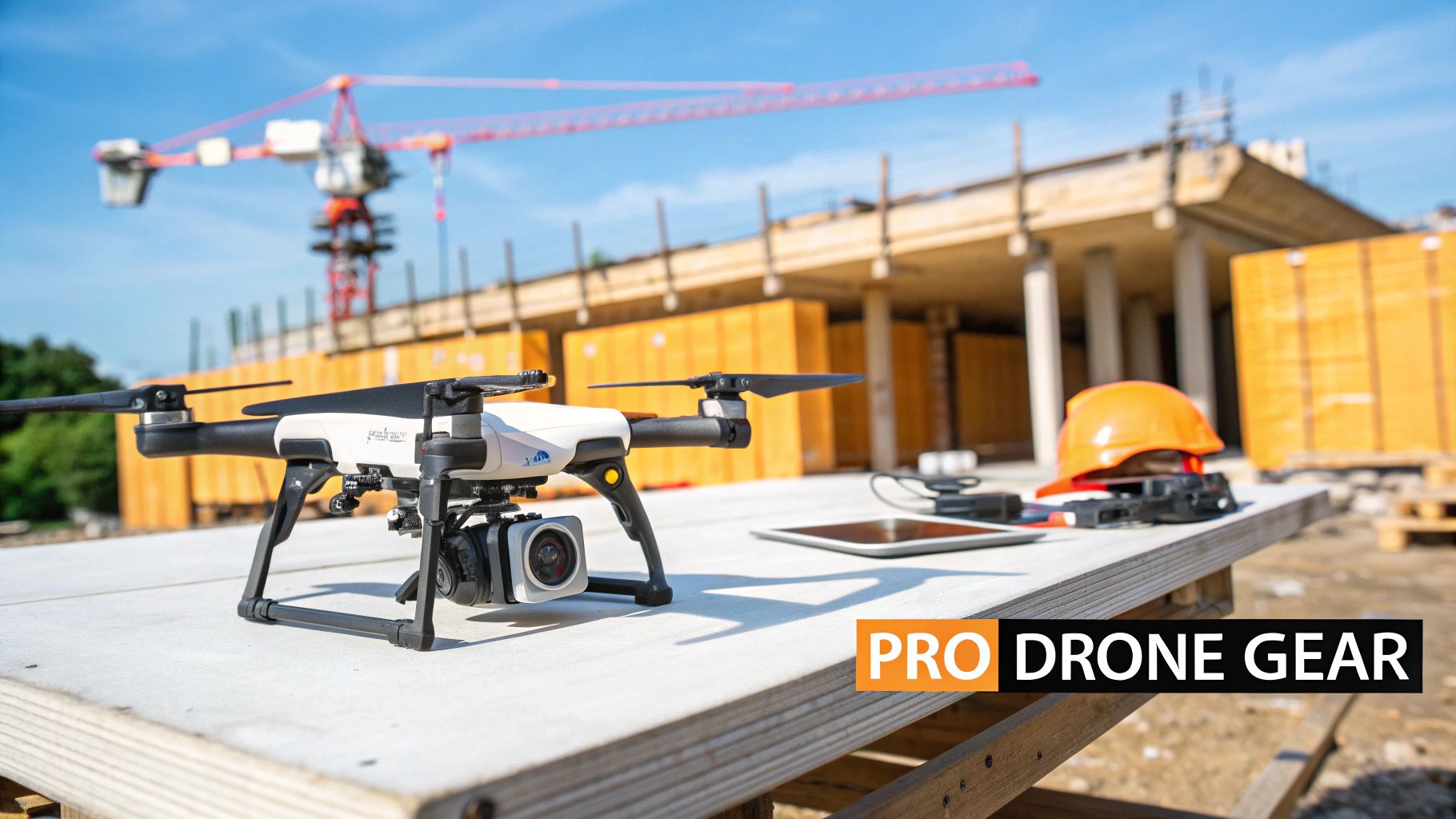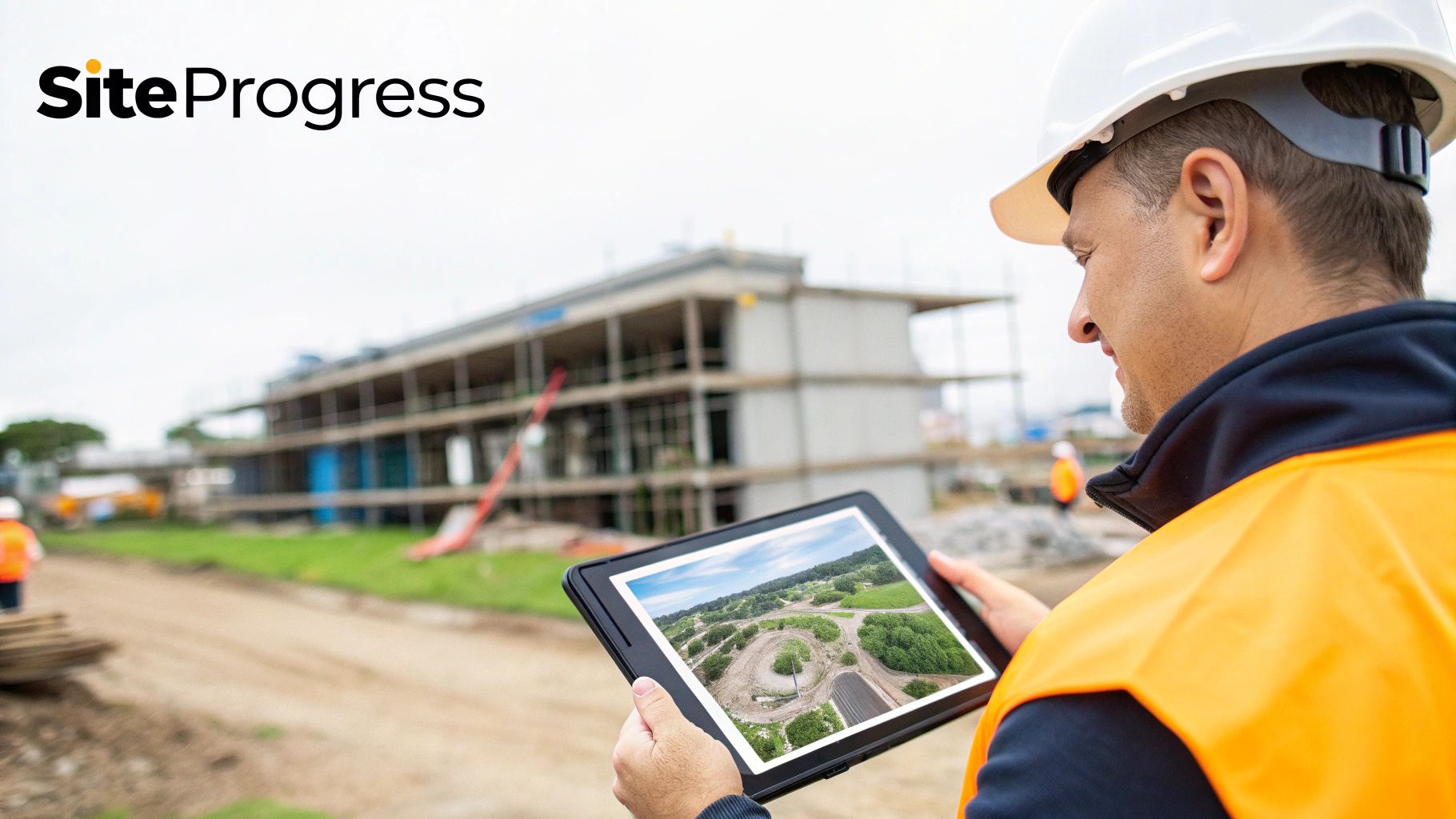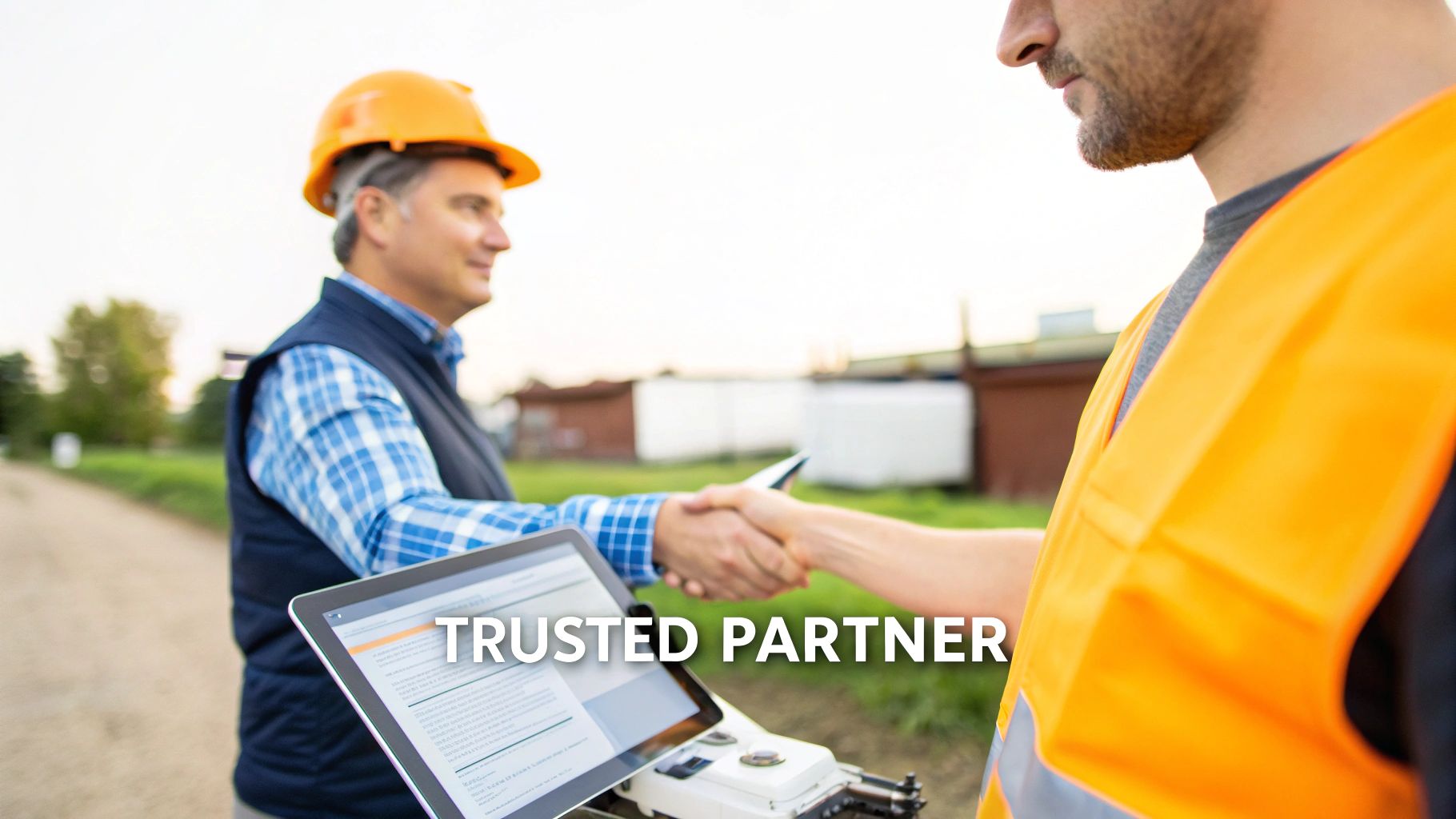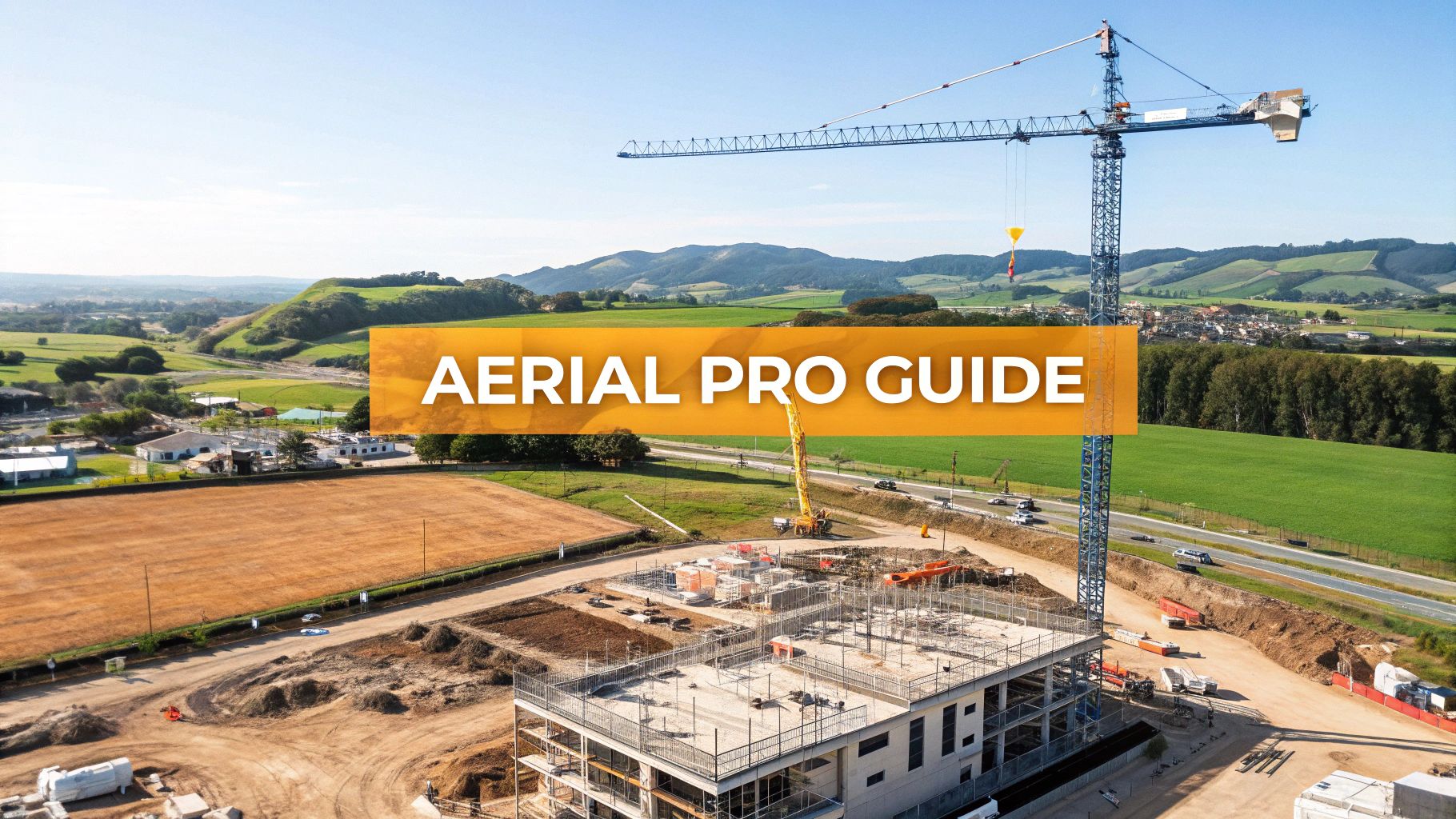


Ground-level photos don’t tell the full story. For construction companies in NZ, professional aerial photography isn't a luxury; it's a tool that wins you work. It creates assets that build trust and prove your capability.
For Kiwi builders, standing out is everything. Your work on-site might be top-notch, but potential clients only see what you show them. Ground shots are fine, but they can’t capture the scale, progress, or complexity of a job.
This is where a view from above gives you a clear return.
Aerial imagery offers a perspective nothing else can. It lets you document an entire site in a single, powerful frame—whether it’s a new build in Tauranga or a commercial development in Auckland. This is about more than nice pictures; it’s about clear, honest proof of your progress and professionalism.
High-quality aerial shots do more than look good on your website. They act as a transparent record of your work, which is vital for building client trust. When a client sees a crisp, high-resolution overview of their project developing each week, it answers questions before they’re even asked.
That level of documentation shows a real commitment to quality and open communication. It turns a simple progress report into a compelling visual story that keeps clients confident and happy.
A bird's-eye view cuts through the noise. It gives stakeholders an honest, comprehensive look at site progress, layout, and the surrounding environment, building confidence from day one.
Using professional aerial photography gives you practical advantages that directly help your bottom line. It’s a smarter way to manage projects and a more effective way to market your business.
Consider these outcomes:
Seeing a robust commercial UAV in New Zealand's South Island in action shows the practical power these tools bring. For construction, this means turning an ordinary project into an impressive case study that helps you win your next job.
Flying a drone over a construction site in New Zealand isn’t a simple ‘point and shoot’ job. The Civil Aviation Authority (CAA) has a serious set of rules. Ignoring them is a surefire way to get fined, cause delays, and create real safety risks.
These regulations aren't just red tape; they protect people and property. For builders, that means protecting your business, your clients, and your reputation. Every flight needs to be safe, legal, and compliant—there’s no room for cutting corners above a busy worksite.
This is why hiring a certified and insured professional is non-negotiable. They handle the complex compliance, so you can focus on what the drone delivers: valuable data and marketing assets.
In New Zealand, the CAA has two main rule sets for drones: Part 101 and Part 102. For any commercial work on a construction site, your operator will be flying under a Part 102 certificate.
Part 101 Rules: Think of this as the 'learner's permit' for drones. It’s for hobbyists and very basic commercial jobs. The rules are strict: you can only fly in daylight, must stay below 120 metres (400 feet), and keep the drone in your line of sight. For a construction site, these rules are too restrictive.
Part 102 Certification: This is the professional standard. A Part 102 certificate is issued to operators who have proven to the CAA that they have solid safety procedures. This certification allows them to fly beyond standard Part 101 rules—enabling flights over property or near people, which are common needs on a construction project.
This decision tree visualizes how aerial photography directly contributes to building trust, providing proof of progress, and creating powerful marketing materials.
Ultimately, each of these benefits reinforces a professional image that helps you win more and better work.
Beyond the CAA rulebook, there's a critical layer of professionalism around privacy. You can’t just fly a drone over private property without getting permission from the owner first.
On your own site, consent is straightforward. But a drone's camera has a wide view and can easily see into neighbouring properties. A professional operator knows how to plan flight paths and frame shots to get the data you need without creeping on the neighbours.
A certified drone operator isn't just a pilot; they're a risk manager. Their job is to get the shots you need while following CAA rules and the Privacy Act, protecting your project from legal trouble.
New Zealand's airspace is a busy, managed environment. Certain areas are off-limits to drones, while others require special clearance. Getting this wrong has serious consequences.
Any professional providing aerial photography NZ services will check airspace restrictions long before they arrive on-site. The key areas they look out for include:
When you work with a certified operator, they take care of all this for you. They sort out airspace authorisations and file the necessary safety plans, ensuring your project is documented safely and efficiently. It takes a huge weight off your shoulders.

Let's be direct: not all drones are created equal. The difference between a consumer drone from a retail store and professional kit is night and day. It’s the difference between a hand saw and a drop saw—both cut wood, but only one delivers the precision and efficiency a professional job demands.
Choosing the right gear isn't about flashy tech. It's about capturing accurate data that helps you manage your project and build your business. The images from a high-end setup are clearer, more detailed, and far more valuable for making real-world decisions.
You get a genuine tool that makes your job easier. When you're looking for an aerial photography NZ provider, their equipment tells you a lot about the quality you can expect.
On a construction site, the camera is as important as the drone. A high-resolution sensor is a must-have. You need to be able to zoom in on an image and see the fine details—check a foundation pour or inspect roofing materials without the picture turning into a blurry mess. Your standard consumer drone won’t cut it.
There's a reason pros fly platforms like the DJI Mavic 3 or Inspire series. These machines are workhorses, built to stay stable in the gusty conditions common on NZ sites. They carry cameras with large sensors that capture crisp, high-megapixel images.
This level of detail is crucial for everything from progress reports to the kind of stunning shots that win you work. These aren't just snapshots; they are high-quality assets that reflect your own commitment to precision, a concept we explore in our guide to professional architectural photography.
The right gear delivers useful data. A high-resolution image lets you spot a potential issue from your desk, saving a site visit and preventing a small problem from becoming a costly one. It’s about efficiency.
Beyond great photos, a professional aerial kit often includes specialised sensors that give you a much deeper understanding of your site. This is where a drone becomes a powerful data collection platform.
These tools can reveal information that's invisible to the naked eye, helping you build smarter and safer.
When a provider offers these services, it shows they understand the demands of construction. They’ve invested in the right tools to deliver not just images, but actionable information that helps you manage projects more effectively.

Having the right gear and your CAA compliance sorted is one thing, but the real measure of success is what aerial photography actually does for you on-site. It's about making a drone a workhorse—a tool that saves time, makes communication effortless, and helps you build your brand.
The uses are direct, practical, and geared towards running a more professional operation. From breaking ground to final handover, aerial imagery gives you a clear, unbiased record of your work. It's an honest look at your progress that solves problems, keeps clients happy, and gives you standout content to win the next job.
Getting an aerial survey before the first digger arrives is a huge advantage. Using techniques like photogrammetry, a drone can map the entire site in high resolution, capturing every contour, noting existing structures, and flagging potential access issues. This is a data-rich blueprint that helps your team plan with precision.
This kind of pre-construction intelligence lets you spot headaches early. Maybe it's an unexpected slope on a steep Queenstown site or tight access in a crowded Auckland suburb. Sorting these things out on paper—not in the middle of a build—saves a huge amount of time, materials, and money.
The value of seeing a site from above can't be overstated. This isn't a new concept in NZ. Back in the 1950s, archaeologists used aerial photos to spot features like Māori pā sites that were invisible from the ground, proving how powerful this perspective is.
One of the most powerful uses for aerial photography NZ is documenting progress. Regular flights—say, every week or fortnight—create an undeniable visual timeline of the build. This sequence of images is concrete proof of progress for clients and investors, keeping them in the loop and confident in your work.
Instead of just telling a client the foundations are poured, you can send them a crisp, high-resolution photo showing a perfectly executed job. That level of transparency builds serious trust and sets you apart.
A consistent visual record is your best communication tool. It eliminates guesswork for stakeholders and provides a clear, easy-to-understand update that speaks louder than any written report.
Once the images are captured, the real work happens in post-production. Today, new tools like AI integration in post-production are making it possible to analyse site data in even more sophisticated ways.
Aerial imagery is also a practical tool for site management. A high-resolution overhead view is invaluable for safety inductions. You can clearly point out hazards, no-go zones, and access routes to new contractors before they set foot on-site.
This same imagery becomes a key asset for your handover packages. Including high-quality aerial photos of the finished project gives the client a comprehensive record of their new property, from the roofing down to the landscaping.
And finally, when the job’s done, there is no better way to showcase your craftsmanship than with aerial shots. A stunning photo of a finished build, capturing its scale and how it sits in the landscape, is your most powerful marketing tool.
These are the hero shots that will dominate your website, social media, and tender documents. They prove your capability in a single glance and help you build a brand that looks as professional online as you are on-site. We talk a lot about turning projects into powerful stories over on the Onsite Media blog, and these images are a core part of that. They don't just close out a project; they're the key to winning the next one.
Long before drones were common on Kiwi worksites, the idea of a view from above was already changing how we saw our country. This isn't a new concept. It has a deep history that shaped how New Zealand was mapped, planned, and built. The goal has always been the same: get a clearer perspective of the land you're working with.
That same principle is just as powerful for a construction site today. Understanding where this started gives us context for the tools we use now. It shows that aerial photography nz has always been about getting better information to make smarter decisions on the ground.
It all started over a century ago. The first aerial photo in New Zealand was taken in 1919 by a pioneer named George Bolt. But the real game-changer came in 1926, when the NZ Air Force flew an aerial survey over the Waimakariri River region. By 1936, a dedicated aerial mapping unit was established, which completely changed how New Zealand's rugged landscape was documented. You can get a great sense of this foundational work in Te Ara's history of New Zealand mapping.
This early work was revolutionary for managing the country's land. For the first time, people could see entire river systems, dense bush, and remote coastlines in one picture. It gave them the power to map landforms and plan infrastructure with an accuracy that was impossible from ground level.
Trying to understand a complex construction site just by walking it is like trying to map the Southern Alps on foot. You only see what’s right in front of you. An aerial view gives you the whole story instantly.
The challenge then was the same as it is now: to see the whole picture. Early aerial surveys provided the big-picture view needed for national development, just as a drone survey today provides the critical overview for a successful build.
Everything we do today with advanced drone technology is built on this foundation. The tools have become incredibly powerful and accessible, but the reason we use them hasn't changed. Whether it’s for a national mapping project or a site progress report for a new build in Queenstown, the bird's-eye view delivers one thing: clarity.

Picking an aerial photography partner isn't like hiring any other subbie. You're not just looking for someone who owns a drone; you need a pro who understands the pressures of a live construction site in New Zealand.
The right partner delivers more than just nice photos—they deliver peace of mind.
Getting it wrong can expose you to safety risks, low-quality images, and compliance headaches you don’t have time for. A true professional protects your project and your reputation by working safely, legally, and efficiently. They become a trusted part of your team, focused on getting you the shots you need to manage your site better and win more work.
This is about finding someone who understands the building industry, not just how to fly. Their work should be an asset that builds your credibility.
Before you even look at a portfolio, there are a few critical boxes any operator must tick. These are the fundamentals of professional aerial photography NZ services. There is no room for compromise.
If a potential partner can’t show you these, walk away.
Here’s what you need to confirm:
Think of CAA certification and insurance as their trade ticket. It’s the baseline proof that they are a qualified professional who takes safety and compliance as seriously as you do.
Once you’ve confirmed the essentials, it’s time to look at their work. A portfolio is more than a gallery of nice pictures; it’s hard evidence they can deliver the specific assets your business needs.
You’re not looking for scenic landscapes. You’re looking for proof.
You want to see a body of work that clearly shows they can capture:
Their ability to supply files in the right formats is just as important. A good partner understands how their images and video fit into your business strategy. If you need help figuring out how this content can drive your business, exploring what a dedicated media and marketing agency can offer is a smart move.
Ultimately, the right photographer gives you files that are ready for your website, social media, and client reports, making your life easier.
We talk to builders all the time, and a few key questions always come up about using drones on-site. Here are some straight-up answers to help you see how aerial photography can work for your projects.
The cost for professional aerial photography NZ services varies. It’s not just about flight time; the price reflects the pilot's experience, their gear, CAA certification, and proper insurance. A quick shoot for a new home build might cost a few hundred dollars. A large commercial site needing multiple flights and 3D modelling is a more significant investment.
The best way to think about it is as an investment, not a cost. The value you get back from tighter project control, great marketing content, and impressed clients almost always outweighs the initial price.
It’s not just about asking "how much?" but "what value am I getting?" A certified pro delivers safety, compliance, and powerful results that help you win more work.
It can be surprisingly quick. For most construction sites, a seasoned drone operator is in and out fast. A standard progress shoot often takes less than an hour on-site. The pilot arrives with a flight plan, runs through safety checks, and gets the shots you need without getting in your team's way.
More involved jobs like a topographic survey or a cinematic video shoot will take longer. Any good operator will run through the timeframe with you beforehand so you know what to expect.
Not much, but a little prep helps. The main thing is to have a quick tidy-up of the areas you want to feature. Shifting a few utes or a stack of materials blocking a key view can make a huge difference.
The most important thing is communication. Give your operator a clear brief on any must-have shots—maybe a close-up of the new foundations or a wide shot showing the property's boundaries. It's also a good idea to let your crew know when the flight is happening. A quick chat beforehand guarantees a smooth shoot every time.
Ready to make your projects stand out with professional aerial photography and video? Onsite Media is New Zealand’s specialist content and marketing studio for the construction industry. We help you look as good online as you do on-site.

